Abstract
Morocco, with its Mediterranean climate and its various potentialities, conceals an important space for the extension of viticulture, in particular that of traditional grape varieties, which has undergone profound upheavals linked to economic, social and environmental constraints which have had a negative impact on genetic diversity. The present study aimed to evaluate the richness of the local phylogenetic heritage of the traditional vines in the North-West of Morocco. For this, we carried out a characterization of a collection of 1617 leaves, taken from 162 vine plants and belonging to 27 different traditional varieties. Thereafter, we used an ampelometric and ampelographic approach with the Super Ampelo software. The ANOVA test revealed the most discriminating parameters, which were the angles, the depth of the lateral sinuses in relation to the lengths of the ribs, and the relationships between all the parameters. In this sense, the qualitative parameters (OIV Codes) confirmed the presence of morphological diversity within the grape varieties studied; the study of general averages made it possible to specify the varieties with the large values of distance/angles and of ratio, and we have shown the presence of a great intra-varietal diversity in addition to that which is inter-varietal. The analysis in principal components allowed the grouping of the grape varieties into five groups according to their expressions by the quantitative parameters, and it confirmed the hypothesis of the influence of the external environment in addition to the gene pool on the grape varieties. This leads us to provide more efforts to maintain inter- and intra-varietal variability and to fight against genetic erosion and the threat of environmental changes.
1. Introduction
For centuries, man has not stopped domesticating animal or plant species. The vine is one of his great successes, a wild liana which over time has undergone very significant development and adaptation at the genetic, physiological and organoleptic levels, as well as varietal diversification [1]. Nowadays, most cultivated varieties are all of the Vitis vinifera species, representing more than 10,000 grape varieties [1,2]. Thus, the products of the vine would occupy the first economic place at the world level [3], explaining its place among the most cultivated fruit trees in the world with 7,528 million ha of area and a grape production of 691 million quintals [4].
Over time, the vine has shown a great capacity to develop on rich soils but also on steeply sloping, rocky and poor soils. The vine has always occupied an important place in the traditional Mediterranean landscape by its presence in these two wild and cultivated forms [5]. The culture of this species is well rooted in the traditions of the Maghreb peasant populations in general, and the Moroccan population in particular. However, the introduction of new wine and table grape varieties by globalization has generated a genetic erosion of the wine heritage [6,7]. This has led to a regression or even the disappearance of a large number of indigenous grape varieties that contain genes for adaptation and resistance to biotic and abiotic constraints.
Faced with the almost total ignorance of our wine heritage and the absence of a descriptive catalog of these grape varieties, it is imperative to recognize the local phylogenetic heritage, given the phytogenetic wealth that the country conceals in this area. In order to identify the diversity of traditional grape varieties in the traditional agroecosystems of the Rif Mountains and their possible conservation, we characterized the traditional grape varieties according to different approaches (ampelographic and ampelometric) recommended by the International Organization of the Vine and Wine (OIV).
2. Experiments
2.1. Sampling
The surveys took place in 13 traditional vineyards (Figure 1), located in the region of Tanger Tétouane Al-Hoceima. This is the northwest section of the Rif arc, which many authors refer to as “Jbala country”. Due to the energetic aspect of its relief, this ensemble is characterized as much by the originality of its environment (mountain, Mediterranean and Atlantic) as by the specificity of its role in both the ancient and contemporary history of the Kingdom. In this region, there are mainly four homogeneous zones: the Tangérois; the coast and the Mediterranean basins; the Bas Loukkos basin; and the Jbala, containing the sampling sites [8].
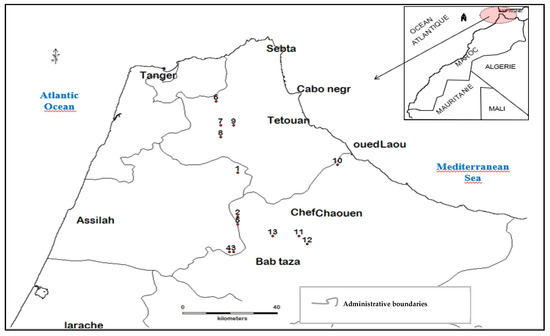
Figure 1.
Location of the surveyed sites.
Sampling was carried out at the time of fruiting. In each prospected vineyard, with the help of the farmer, we collected samples of leaves for each named and recognized grape variety. Thus, for each plant, we collected 10 to 20 leaves located between the 7th and 12th node, counted from the base of the primary branch, according to the recommendations of the OIV [9].
2.2. In the Laboratory
After drying and organizing the leaves harvested in a herbarium, they were scanned and the images obtained were processed by the Super Ampelo measurement software, which is a program designed to help catalog the genetic material of the vine by ampelographic and ampelometric characters, according to the descriptors of the OIV [10].
3. Results
Although the area of distribution of the vine within the traditional agroecosystems of the Rif Mountains is very restrained, our study revealed a very important diversity made up of 27 traditional grape varieties: Ainab byed (AIB), Aineb Noir (AIN), Albaydi (ALB), Labyed (LBY), Alfasi (ALF), Alkouz (ALK), Babour Hmara (BABH), Boukhanzir (BKH), Boukwanes (BKW), Bezul laawda (BZA), Bezul laawda byed (BZAB), Bezul laawda hmer (BZAH), Chouikhi (CH), Douak (DAK), Eddibani (EDD), Feqqas (FKS), Hmar Bouaamar (HBA), Houmrani (HMR), Jenyani (JNY), Lechehab (LCH), Matecha (MTCH), Sbiyae Lebnat (SBLB), Taferyalt (TFR), Taferyalt byed (TFRB), Taferyalt Sfar (TFRJ), Taferyalt Lakhal (TFRN), Valenci (VAL).
3.1. Qualitative Characterization of the Adult Leaf
3.1.1. Shape of Blade
According to OIV 067, we distinguished between five groups of grape varieties (Figure 2); grape varieties with a pentagonal shape made up a proportion of 83%, while 8% had a wedge shape, 6% had a circular leaf, and only 1% had heart-shaped leaves.

Figure 2.
Shape of blade.
3.1.2. Number of Lobes
According to OIV 068, the majority of grape varieties studied (96%) had leaves with five lobes, 2% with three lobes, 1% with seven lobes and 1% with one lobe (Figure 3).

Figure 3.
Number of lobes.
3.1.3. Shape of Teeth
According to OIV 076, we noticed that the majority of grape varieties had rectilinear toothed leaves observed on both sides (99%). However, 1% had two-sided convex teeth (Figure 4).

Figure 4.
Shape of teeth.
3.1.4. Degree of Opening of Petiole Sinus
Concerning OIV 079, it was observed that on the sampled grape varieties, 57% presented leaves with a closed petiole sinus, while 31% had leaves with half overlapping sinuses and 12% had leaves with open petiolar sinuses (Figure 5).
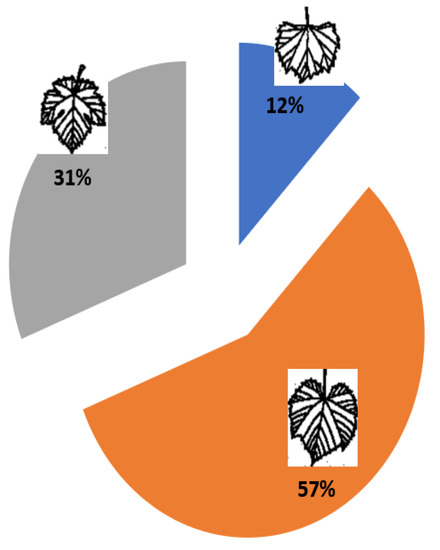
Figure 5.
Degree of opening of petiole sinus.
3.1.5. Shape of Sinus
Taking into account the OIV 083 1, we noted the presence of two forms of sinus in the grape varieties studied, with 96% of individuals having U-shaped petiole sinuses, and 4% with V-shaped sinuses (Figure 6).
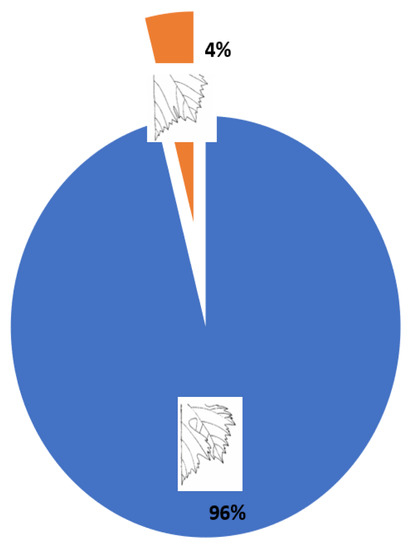
Figure 6.
Shape of sinus.
3.1.6. Teeth in the Petiole Sinus
Regarding OIV 081 1, it was noted that 94% of the grape varieties studied were characterized by the absence of teeth in the petiolar sinus, against 6% which had the particularity of the presence of teeth (Figure 7).
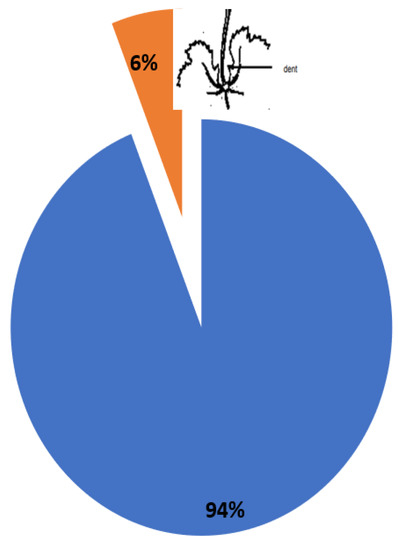
Figure 7.
Teeth in the petiole sinus.
3.2. Quantitative Characterization of the Adult Leaf
The analysis of variance made it possible to specify the importance of the variability of the 86 ampelometric parameters of the leaves likely to differentiate the grape varieties. In this context, the analysis of variance for the 73 most discriminant parameters out of the 86 measured showed a highly significant difference between the different grape varieties (p <0.0001), which is the result of a significant morphological diversity within and between the different individuals that make up these grape varieties. This difference is expressed more with very high F for the characteristics related to the size and the base of the teeth (HD, BD), shape of the teeth (HBD1), petiole opening angle (PI), and surface (Area) (Table 1).

Table 1.
ANOVA analysis of the various ampelometric measured parameters.
4. Discussion
To get an idea of the structure of the variation in the various parameters measured, a principal component analysis was performed on a matrix encompassing the 27 traditional grape varieties, taking into account the 73 variables considered in the study (Figure 8).
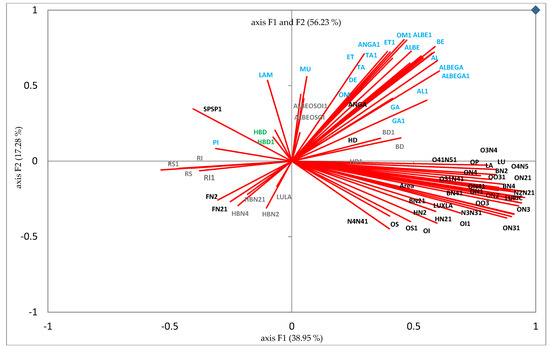
Figure 8.
Projection of the variables on the plan [1,2].
Most of the variance expressed by axis F1 is explained by the correlation with the variables related to the following distances: leaf width (LA), leaf length (LU), length of veins and ribs (N1, N2, N3, N4 and N5), distance between vein tips (N2-N21, N3-N31 and N4-N41), leaf length including petiole (LUPIC), surface (Area), and petiole length (OP). As for axis F2, it is correlated with the variables related to the following angles: angle between I and I ‘(MU), angle between S and S1 (LAM), angle between N2 and N2’ (DE), angle between N1 and N2 (OM), angle between N2 and N3 (ET), angle between N3 and N4 (TA), the sum of the angles AL + BE (ALBE), and the sum of the angles AL1 and BE1 (ALBE1). This axis is also correlated with the ratio between the sum of the angles AL + BE and between the sum of the petiolar sinuses OS and OI (ALBEOSOI).
Considering the number of grape varieties studied, we carried out two projections; one made up solely of “Taferyalt”, a grape variety which is more representative of the sites; and a second projection, encompassing the rest of grape varieties without “Taferyalt”.
The PCA grouping together all varieties with the exception of “Taferyalt” (Figure 9) showed the existence of three categories depending on the variation of distances and angles. Category 1 constitutes the pole of the positive side of axis F1, which groups LBY (100%), VAL (100%), MATCH (100%), BZAB (100%), then CH (75%), FKS (60%), ALB (50%), and BZA (50%); this category is distinguished by large corner sheets. Category 2 constitutes the intermediate pole which includes HBA (100%), SBLB (100%), BKH (100%), ALF (100%), JNY (100%), DAW (100%), AIB (100%), LCH (100%), ALK (100%), FKS (40%), BZA (50%), ALB (50%), EDD (40%) and CH (25%); this category is distinguished by medium sized corner sheets. Category 3 constitutes the pole of the negative side of axis F1 which includes AIN (100%), BABH (100%), BZAH (100%), BKW (100%), HMR (100%), and EDD (60%); this category is distinguished by sheets of angles of small size.
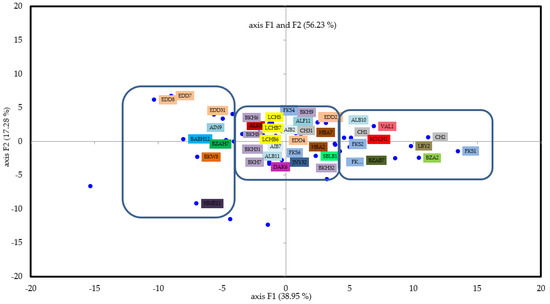
Figure 9.
Projection of grape varieties without Taferyalt.
However, the FKS, BZA, ALB and CH grape varieties are divided between categories 1 and 2, and the EDD grape variety between categories 2 and 3.
Regarding the second projection of the ACP with the “Taferyalet” grape varieties (Figure 10), we also made a distinction between three categories: Category 1 constitutes the pole of the positive side of axis F1, by grouping TFRN (100%) and TFRJ (100%); Category 2 constitutes the intermediate division regrouping TFR (100%); and Category 3 constitutes the pole of the negative side of axis F1, comprising TFRB (100%).
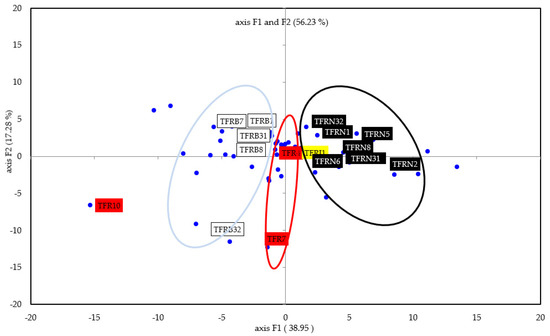
Figure 10.
Projection of grape varieties with Taferyalt.
Although the study was based only on the morphological characters of the leaf, a significant intra- and inter-grape variability has been demonstrated. The interest and importance of this variability are particularly interesting insofar as they have been demonstrated over a small and relatively delimited territory.
5. Conclusions
This study constitutes a contribution to the characterization of the traditional grape varieties of the vines in the traditional agroecosystems of the Rif Mountains, using ampelographic and ampelometric parameters. These approaches are complementary and allow a better understanding of the diversity of local varieties of the vines. This study allowed us to collect preliminary data concerning the phenotypic characteristics of traditional grape varieties.
From the ampelographic approach, it emerges that the majority of the quantitative and qualitative parameters used demonstrate the existence of intra- and inter-grape variability within the individuals studied. As a result, it remains the main and essential tool for identifying grape varieties [11]. However, the morphological characters are influenced by environmental factors, such as soil properties [12], water availability and salinity [13], the nature of the rootstock [14], the level of nutrition [15], and the health of the plant [16], without forgetting the problem of synonymy and homonymy, especially in the case of vernacular names, which may differ for the same variety depending on the region of sampling. For this, it is of major importance to complete the present study with a molecular characterization.
Supplementary Materials
The poster presentation is available online at https://www.mdpi.com/article/10.3390/BDEE2021-09461/s1; the video presentation is available online at https://sciforum.net/event/BDEE2021/keynote/d3e38509c6b12b24a27cd53ba40856e9/presentation_video/Ampelometric%20and%20ampelographic%20characterization%20of%20leaves%20of%20indigenous%20%E2%80%9CVitis%20vinifera%20ssp.%20Vinifera%E2%80%9D%20in%20the%20North%20of%20Morocco%20PP%20RVE.mp4.
Acknowledgments
The authors thank the farmers of the various villages who contributed to the realization of this study. This research was funded by ARIMNET 2 Project “MedVItis” Convention No. 7.
Conflicts of Interest
The authors declare no conflict of interest.
References
- Zohary, D.; Hopf, M. Domestication of Plants in the OID World; Oxford University Press: Oxford, UK, 2000; ISBN 0-19-850356-3. [Google Scholar]
- This, P.; Lacombe, T.; Thomas, M.R. Historical origins and genetic diversity of wine grapes. Trends Genet. 2006, 22, 511–519. [Google Scholar] [CrossRef] [PubMed]
- Vivier, M.A. Genetically modified grapes to increase endogenous disease resistance. In Proceedings of the Thirteenth International Oenological Symposium, Montpellier, France, 9–12 June 2002. [Google Scholar]
- The International Organisation of Vine and Wine. 36 éme Congrès Mondial de la Vigne et du vin; OIV: Bucarest, Roumanie, 2013. [Google Scholar]
- Bouby, L.; Terra, L.J.-F.; Figueiral, I.; Tabard, E.; Ivorra, S.; Lacombe, T.; Pastor, A.T.; Picq, S.; Buffat, L.; Fabre, L.; et al. La vigne sauvage (Vitis vinifera subsp. sylvestris): Une plante cultivée dans les établissements viticoles de la Narbonnaise. In Des Hommes et des Plantes, Exploitation du milieu et gestion des ressources végétales de la préhistoire à nos jours. XXXè rencontres internationales d’archéologie et d’histoire d’Antibes; APDCA: Alcabideche, Portugal; pp. 129–139.
- Metal Packaging Manufacturers Association. Situation de l’agriculture marocaine n°9. Ministère Agric. Pêche Marit. 2011, 202, 141–143. [Google Scholar]
- Sbaghi, M. Contribution à L’étude des Maladies Cryptogamiques de la Vigne (Vitis Viniféra) dans la Région de Saïs. Rapport-INRA-Maroc, 1997; 78p. [Google Scholar]
- Monographie Régionale. La région de Tanger-Tétouan-Al Hoceima. Direction Régionale de Tanger-Tétouan-Al Hoceima. 2018. Available online: https://www.hcp.ma/region-tanger/attachment/1322593/ (accessed on 10 March 2021).
- The International Organisation of Vine and Wine. Descriptor List for Grape Varieties and Vitis Species, 2nd ed.; OIV: Paris, France, 2009. [Google Scholar]
- Soldavini, C.; Stefanini, M.; Dallaserra, M.; Policarpo, M.; Schneider, A. Superampelo, a software for ampelometric and ampelographic descriptions in Vitis. Acta Hortic. (ISHS) 2006, 827, 253–258. [Google Scholar] [CrossRef]
- Martinez, M.C.; Grenan, S. A graphic reconstruction method of an average leaf of vine. Agronomie 1999, 19, 491–507. [Google Scholar] [CrossRef] [Green Version]
- Ferree, D.C.; Streeter, J.G. Response of container-growing grapevines to soil compaction. HortScience 2004, 39, 1250–1254. [Google Scholar] [CrossRef] [Green Version]
- Fisarakis, I.; Chartzoulakis, D.; Stavrakas, D. Response of sultana vines (V. vinifera L.) on six rootstocks to NaCl salinity exposure and recovery. Agric. Water Manag. 2001, 51, 13–27. [Google Scholar] [CrossRef]
- Krstic, M. Lyapunov adaptive stabilization of parabolic pdes-part i: A benchmark for boundary control. In Proceedings of the 44th IEEE Conference on Decision and Control, Seville, Spain, 15 December 2005. [Google Scholar]
- Schriener, R.P.; Lee, J.; Skinkis, P.A. N, P and K supply to pinot noir grapevines: Impact on vine nutrient status, growth, physiology and yied. Am. J. Enol. Vitic. 2012, 64, 26–38. [Google Scholar] [CrossRef]
- Cervera, M.T.; Rodreguez, I.; Cabinaz, J.A.; Chavez, J.; Martinez Zapater, J.M.; Cabbelo, F. Morphological and molecular characterezation of grapevines accessions known as Albello. Am. J. Enol. Vitic. 2001, 52, 127–135. [Google Scholar]
Publisher’s Note: MDPI stays neutral with regard to jurisdictional claims in published maps and institutional affiliations. |
© 2021 by the authors. Licensee MDPI, Basel, Switzerland. This article is an open access article distributed under the terms and conditions of the Creative Commons Attribution (CC BY) license (https://creativecommons.org/licenses/by/4.0/).